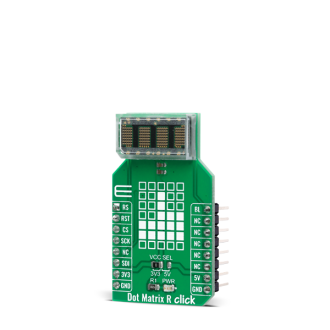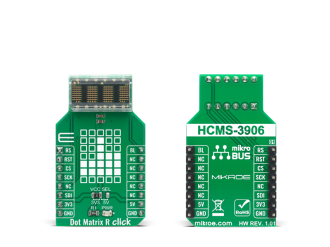
We strongly encourage users to use Package manager for sharing their code on Libstock website, because it boosts your efficiency and leaves the end user with no room for error. [more info]

Rating:
Author: MIKROE
Last Updated: 2020-07-10
Package Version: 1.0.0.0
mikroSDK Library: 1.0.0.0
Category: LED matrix
Downloaded: 2998 times
Not followed.
License: MIT license
Dot Matrix R Click is a display device Click board based on a four-digit dot matrix display module, labeled as HCMS-3906. The module holds four 5x7 dot matrices, with very closely spaced, bright red pixel elements. Characters are very clearly displayed as a result.
Do you want to subscribe in order to receive notifications regarding "Dot Matrix R click" changes.
Do you want to unsubscribe in order to stop receiving notifications regarding "Dot Matrix R click" changes.
Do you want to report abuse regarding "Dot Matrix R click".


Library Description
Library provides functions for parsing and communicating with device for communication and controlling pins.
Key functions:
void dotmatrixr_write_ascii ( char *ascii_data ) - Function for showing string to displayvoid dotmatrixr_generic_write ( uint8_t *tx_buf, uint8_t buf_len ) - Function for writing data to devicevoid dotmatrixr_restart ( void ) - Function for restarting deviceExamples description
The application is composed of three sections :
void application_task ( )
{
dotmatrixr_write_ascii( &demo_t1[ 0 ] );
Delay_ms( 1000 );
dotmatrixr_write_ascii( &demo_t2[ 0 ] );
Delay_ms( 1000 );
dotmatrixr_write_ascii( &demo_t3[ 0 ] );
Delay_ms( 1000 );
}
Other mikroE Libraries used in the example:
Additional notes and informations
Depending on the development board you are using, you may need USB UART click, USB UART 2 click or RS232 click to connect to your PC, for development systems with no UART to USB interface available on the board. The terminal available in all MikroElektronika compilers, or any other terminal application of your choice, can be used to read the message.